White House welcomes: State dinner to cold shoulder
- Published
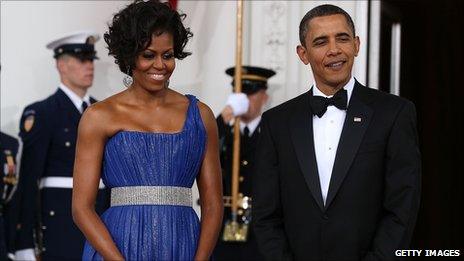
Every step of a foreign leader's visit to Washington is carefully orchestrated
As US President Barack Obama prepares to welcome UK leader David Cameron, the BBC's Katie Connolly, in Washington, decodes the different hues of White House welcomes.
In foreign affairs, like most political arenas, appearances matter. Dignitaries engage in delicate shuffles - being seen with the right people, bending the ears of the powerful - to cement perceptions of their influence.
Few leaders understand these elaborate dances better than US presidents, and lucky for them they have a few tricks up their sleeve to charm and flatter - or cajole and cool - their international peers.
From glamorous state dinners and trips to Camp David, to a humble coffee in the Oval Office, every step of a foreign leader's visit to Washington is carefully orchestrated to send pertinent signals to audiences at home and abroad.
The Oval Office Meeting
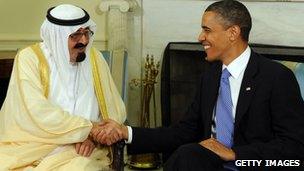
Press photographers captured Mr Obama's Oval Office meeting with Saudi King Abdullah in June
This is standard fare for a visit by a head of government. The meetings usually last less than an hour, and are attended by six to eight aides of the leader's choosing on each side.
But it's the bells and whistles that count: If a leader is ushered in and out of an Oval Office meeting without so much as a handshake photo, they know they're in the bad books.
Coffee will be served at Oval Office meetings, but some leaders are treated to lunch in the White House.
Many participate in a small press conference and photo opportunity seated in chairs in the Oval Office, a tradition often attributed to President Franklin D Roosevelt who was virtually wheelchair-bound after a battle with polio - a fact he did not like to draw public attention to.
Last year, when a press conference with the British prime minister at the time, Gordon Brown, was held as the two men sat on armchairs in the Oval Office, the British media speculated whether this represented a snub, because the event lacked the pomp of the East Room.
The East Room Press Conference
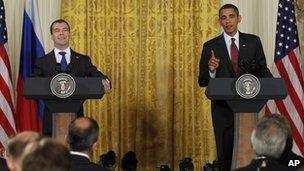
The ornate East Room is the site of many joint presidential press conferences
Holding a joint press conference with the president in the ornate East Room (or, weather permitting, in the famed Rose Garden) elevates a visitor's status.
Heads of government in the UK and Australia - who, Gordon Brown notwithstanding, are often granted an audience in East Room press conferences - like to tout these affairs as evidence of their "special relationship" with the US.
Leaders usually take several questions, alternating between foreign and local reporters.
The East Room affair must be offered by the US, but insiders say that if it isn't, foreign officials will often politely encourage an invitation.
The State Dinner
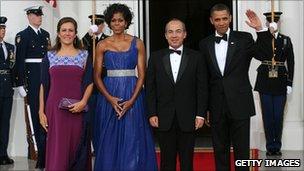
Only select leaders experience the fashion and flair of a state dinner
The State Dinner is the crowning jewel of White House hospitality, but can only be offered to those invited to the US for an official state visit.
These generally involve a head of state, but occasional exceptions are made for heads of government.
For the UK, that means that traditionally the Queen, not the prime minister, is the honouree at such a dinner.
State Dinners involve much pomp and circumstance, including honour guards, a receiving line and, of course, fabulous fashion. State visits often also include welcoming ceremonies, a 21 gun salute and an invitation to address Congress.
Mr Obama's first state dinner for Indian Prime Minister Manmohan Singh last November was marred by the presence of now-infamous gate crashers, DC socialites Michaele and Tareq Salahi.
The Trip to Camp David

President Clinton tried to broker a Mid-East peace deal at Camp David
Camp David is the Presidential retreat, and many presidents use it to as a way to build personal relationships with foreign leaders outside of the demands of Washington protocol.
President George W Bush for example, found state dinners to be unproductive, preferring to interact with favoured leaders at his ranch in Texas or Camp David.
Mr Bush even once took Japan's Prime Minister Junichiro Koizumi, an Elvis Presley fanatic, on a trip to the rock star's Graceland Estate in Memphis, Tennessee. (They flew on Air Force One of course, yet another tool in the president's charm armoury.)
Unlike Mr Bush, Mr Clinton didn't have a family property and found that his allergies kicked in at Camp David.
Mr Clinton preferred ceremonial dinners and conferences like APEC, where he could indulge his wonkish tendencies and also his proclivity for schmoozing and gossiping with his peers.
Mr Obama has spent several weekends with his family at Camp David, but has yet to take a foreign leader there.
The Accidental Meeting
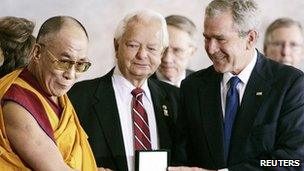
Meeting with the Dalai Lama can cause tension between the US and China
Meeting with some foreign leaders can put the president in an awkward position. Case in point: the Dalai Lama.
Treating the Dalai Lama as a political leader aggravates China. To get around this, President Clinton's staff would engineer a meeting with the vice president or first lady, and then have Mr Clinton "spontaneously" drop in.
President George W Bush opted to meet with the Dalai Lama in the residence, rather than the Oval Office, emphasizing the Tibetan's status as a religious rather than political leader.
After initially declining to meet him, Mr Obama received the Dalai Lama at the White House in February.
Presidents occasionally stage more casual photo ops to foster the impression of budding friendship.
Mr Obama, for example, recently took his new pal President Dmitry Medvedev of Russia to one of his favourite local joints - Ray's Hell Burger - for cheeseburgers and fries. And of course, the cameras followed.
Events with the First Lady
A happy spouse can make for a happy leader, so the First Lady's office may prepare a programme for the spouse of a particularly important dignitary.
Programmes might involve lunches, visits to schools and galleries or even tree planting.
Staying at Blair House
Situated across from the White House on Pennsylvania Avenue, Blair House is the official guest residence of the president.
Usually reserved for heads of state, guests must be invited to stay there by the president.
Excellent security and proximity to the White House are some of the advantages of Blair House.
- Published23 June 2010